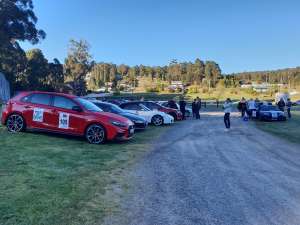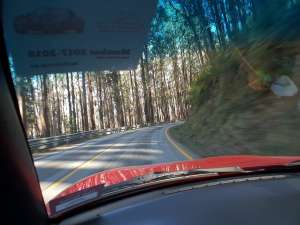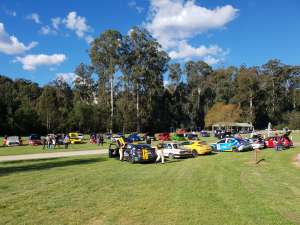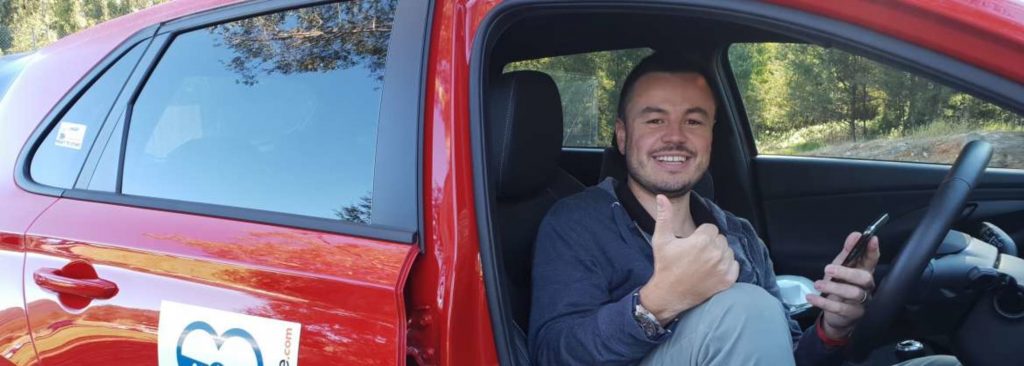Written by Paul Maric:
I remember watching Targa Tasmania tarmac rally one year and thinking how cool it would be to get a race car and have a crack. It wasn’t long before I realised it’s much harder than it looks, it’s much more expensive than it looks, and I’d likely run out of skill shortly before spearing off the road into a tree.
Well, earlier this year when the team from Drive Against Depression asked if I wanted to take part in the Australian Tarmac Rally Championship, I was super excited until those rushes of fear from my long-lost Targa ambitions hit me.
It was around that time that Sarah, who runs the charity, explained that there’s another category attached to the main event that required less skill, less roll cage and could be done in a standard car. It’s the racing equivalent of being a bridesmaid – you get to have all the fun without all the pressure.
Before she finished explaining, I was already on the phone to Hyundai to ask if I could borrow an i30 N to tackle the Marysville/Lake Mountain stages of the Australian Tarmac Rally.
The category attached to the main event is called the Touring category. All you need to take part is a working and roadworthy car, along with a two-day license from Australian Auto Sport Alliance (AASA).

The two-day event takes place on a number of roads you’ve probably already driven, except this time around they’re closed, and you can use the entire road. I literally had a smile from ear to ear when I heard this part of it.
It works like this – the Touring group lines up in formation behind the race cars. The race cars leave the start line of each stage with no speed limit and a timing device called a Rallysafe (more on this shortly). Once each race car has left, a sweep vehicle runs through and the Touring category sets off.
Each vehicle in the Touring category is spaced by around 5-10 seconds with the order determined by the driver’s confidence in their driving ability. Throughout the day, the order is shuffled as you start catching the cars ahead of you following the start gap.
Unlike the race cars, the Touring category is speed limited to 130km/h with each vehicle fitted with a Rallysafe device. It logs your speed and alerts you if you breach the speed limit – hit it several times and you’ll have a case to explain. But, as I discovered, you’ll rarely hit the 130km/h speed limit with most of the sections comprising twisty mountain roads.

The other benefit to the Rallysafe device is an inbuilt monitoring system that can alert other participants if you spot a hazard on the road or if you’re involved in an accident. Given there’s no oncoming traffic, you rely on the device to deliver all the information you need to troop ahead without worrying about obstacles.
Arguably the best part about the event (aside from some seriously awesome race cars) is the varying level of cars in the Touring category and the varying levels of ability. It meant that people that were driving sports cars, but with limited experience, could hang at the back of the pack and enjoy themselves, while those more serious could stick towards the front.
At the end of the first stage you won’t find a happier group of people. Everybody is beside themselves in joy at the realisation of what they’ve just been allowed to do. Driving as hard as they want with no police, cyclists or oncoming traffic.
How did the Hyundai i30 N perform? Like you wouldn’t believe. I started off in the middle of the pack because I wasn’t sure about the level of abilities or vehicles we’d come across. Throughout the day the i30 N worked its way up the pack to the point where it was keeping up with some serious machinery.
I’ve driven the i30 N at the race track and was impressed with it, but on an open road with varying levels of traction and road quality, it’s taken to the next level. The limited-slip differential constantly affords traction, while the sticky Pirelli rubber offers plenty of grip.
Then there’s the noise. I drove some stages with the windows down because there was induction noise and the meatiest exhaust note this side of a modified hot hatch. Plus it begins sounding like a shotgun on the overrun through downhill stages.
In-gear acceleration is bloody awesome and most of the stages could be done in second and third gear, pinning me back in the seat each time I assaulted the throttle. I drove each stage in N Custom mode, which is configured using the infotainment system and activated using a button on the steering wheel.
My custom mode was set for suspension in Sport mode (between comfort and the hardcode firm setting), steering in comfort mode and engine and exhaust in their highest settings and the stability control in its least effective setting.
That all worked perfectly until the last stage where one of the race cars left oil at the start line at the top of Lake Mountain (which has a sketchy surface to begin with). Around 200m after the start line is a right-hand hairpin. With cold tyres and a bit of oily residue on the treads it drifted around the entire corner!
If you thought it was a placid front-wheel drive hatch, Hyundai has managed to dial in stacks of emotion and enough playfulness (I hate that word, but it sums it up perfectly) to keep you on your toes. The absolute best part is that because it’s a non-timed event (for the Touring category), the i30 N warranty remains intact.
While the cost of competing in the Australian Tarmac Rally Touring stage may seem steep, keep in mind the average track day costs around $200-300 and you end up driving around and around the same track all day.
This event spans two days, includes driving from dawn to dusk and allows you to drive virtually flat out on roads you would never otherwise be able to drive this hard on and sets you back $750. Book through our Drive Against Depression home page, and a portion of that goes directly to the charity!
The price also includes scrutineering, hire of the RallySafe device, dinner on the Saturday night and guidance from professional drivers to get your car seating position set up for the drive. If you’d like to bring a friend as a co-driver, it’s an additional $50, which includes dinner for them on the Saturday night too.

At the end of the first day Drive Against Depression organised a display of all event cars and public vehicles right in the heart of Marysville. It was a great opportunity to meet supporters of the charity and check out some incredible cars and race cars.
Would I do an event like this again? Absolutely, 100 per cent. It was so much fun and a rare opportunity to explore some incredible roads in a state that often struggles with understanding car culture.

